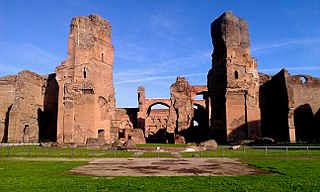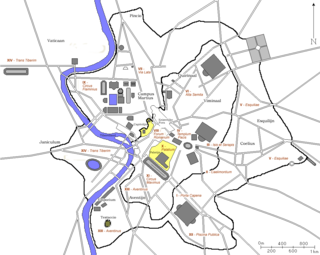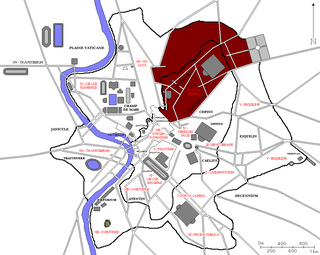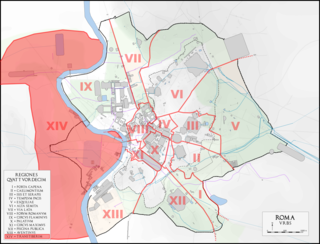
The Regio XII Piscina Publica is the twelfth regio of imperial Rome, under Augustus's administrative reform. Regio XII took its name from the Piscina Publica , a swimming pool that disappeared during the middle imperial period.

The Regio XII Piscina Publica is the twelfth regio of imperial Rome, under Augustus's administrative reform. Regio XII took its name from the Piscina Publica , a swimming pool that disappeared during the middle imperial period.

Regio XII was named after the principal feature of this area during the reign of Augustus, the Piscina Publica, a public reservoir and swimming pool, built around the 3rd century BCE. In extent, this region was bordered by the Vicus Piscinae Publicae to the north, the Via Ostiensis to the west, the Via Appia and the Via Latina to the east, and the Aurelian Walls to the south. Its principal gates through the walls were the Porta Appia and the Porta Ardeatina. A measurement taken at the end of the 4th century recorded that the perimeter of the region was 12,000 Roman feet (approximately 3.5 km), making it one of the smaller of the Augustan regions. [1]

The Piscina itself sat in the low-lying area between the Via Appia, the Servian Wall, and the northeast slope of the Aventine Hill. If it was still present, it was eventually destroyed to make way for the monumental Baths of Caracalla in the 3rd century CE, whose massive ruins are still visible. [2] In addition, the region hosted the Temple of Bona Dea and contained the house of the Roman consul Lucius Fabius Cilo, which was eventually turned into the church of Santa Balbina. Its principal street was the Via Nova, which ran parallel to the Via Appia, and took people from the Circus Maximus to the Baths of Caracalla.
In the 180s, a bank and exchange for Christians operated in this region. [3] The region also contained the station of the fourth cohort of the Vigiles . At the turn of the 5th century, the Regio contained 17 aediculae (shrines), 113 domūs (patrician houses), 27 horrea (warehouses), 63 balneae (bath houses) and 81 loci (fountains). [4]
At the turn of the 5th century, the Regio was divided into 17 vici (districts) and 2,487 insulae (blocks). It had two curators and was served by 48 Roman magistrates. [5]

The Baths of Caracalla in Rome, Italy, were the city's second largest Roman public baths, or thermae, likely built between AD 212 and 216/217, during the reigns of emperors Septimius Severus and Caracalla. They were in operation until the 530s and then fell into disuse and ruin.

In 7 BC, Augustus divided the city of Rome into 14 administrative regions. These replaced the four regiones — or "quarters" — traditionally attributed to Servius Tullius, sixth king of Rome. They were further divided into official neighborhoods.

San Saba is the 21st rione of Rome, identified by the initials R. XXI. It is located within the Municipio I, and takes its name from the Basilica of San Saba, which is located there.
During the Middle Ages, Rome was divided into a number of administrative regions, usually numbering between twelve and fourteen, which changed over time.

In ancient Rome, the Piscina Publica was a public reservoir and swimming pool located in Regio XII. The region itself came to be called informally Piscina Publica from the landmark. The piscina was situated in the low-lying area between the Via Appia, the Servian Wall, and the northeast slope of the Aventine Hill, an area later occupied by the Baths of Caracalla.

The Aqua Anio Vetus was an ancient Roman aqueduct, and the second oldest after the Aqua Appia. It was commissioned in 272 BC and funded by treasures seized after the victory against Pyrrhus of Epirus. Two magistrates were appointed by the Senate, the censors Manius Curius Dentatus who died five days after the assignment, and Flavius Flaccus. The aqueduct acquired the nickname of "old" (vetus) only when the Anio Novus was built almost three centuries later.

The Regio I Porta Capena is the first regio of imperial Rome, under Augustus's administrative reform. Regio I took its name from the Porta Capena, a gate of the Servian Walls, through which the Appian Way entered the city prior to the construction of the Aurelian Walls.

The Regio II Caelimontium is the second regio of imperial Rome, under Augustus's administrative reform. It took its name from the Caelian Hill, which the region was centred on.

The Regio III Isis et Serapis was the third regio of imperial Rome, under Augustus's administrative reform. Regio III took its name from the double sanctuary of Isis and Serapis, in the area of the Via Praenestina, containing the valley that was to be the future site of the Colosseum, and parts of the Oppian and Esquiline hills.

The Regio IV Templum Pacis is the fourth regio of imperial Rome, under Augustus's administrative reform. Regio IV took its name from the Temple of Peace built in the region by the emperor Vespasian. It includes the valley between the Esquiline and the Viminal hills, the popular area of the Subura, and the Velian Hill.

The Regio V Esquiliae is the fifth regio of imperial Rome, under Augustus's administrative reform. Regio V took its name from the Esquiline Hill. It contains parts of the Oppian Hill and Cispian Hill and of the Esquiline, plus the plain just outside the Servian walls.

The Regio VI Alta Semita is the sixth regio of imperial Rome, under Augustus's administrative reform. Regio VI took its name from the street passing over the Quirinal Hill. It was a large regio that also encompassed the Viminal Hill, the lower slopes of the Pincian, and the valleys in-between.

The Regio VII Via Lata is the seventh regio of imperial Rome, under Augustus's administrative reform. Regio VII took its name from the wide urban street the Via Lata. It was the urban section of the Via Flaminia, which ran between the Servian walls and the Aurelian Walls, and corresponds to the modern Via del Corso. The regio contained part of the Campus Martius on the east of the street plus the Collis Hortulorum, the Pincian Hill.

The Regio VIII Forum Romanum Magnum is the eighth regio of imperial Rome, under Augustus's administrative reform. Regio VIII took its name from the Roman Forum, the political epicentre of Ancient Rome.

The Regio IX Circus Flaminius is the ninth regio of imperial Rome, under Augustus's administrative reform. Regio IX took its name from the racecourse located in the southern end of the Campus Martius, close to Tiber Island.

The Regio X Palatium is the tenth regio of imperial Rome, under Augustus's administrative reform. Regio X took its name from the Palatine Hill and the imperial palaces located on it.

The Regio XI Circus Maximus is the eleventh regio of imperial Rome, under Augustus's administrative reform. Regio XI took its name from the Circus Maximus, located in the valley between the Palatine and the Aventine hills.

The Regio XIII Aventinus is the thirteenth regio of imperial Rome, under Augustus's administrative reform. Regio XIII took its name from the hill which dominated the region, the Aventine.

The Regio XIV Transtiberim is the fourteenth regio of imperial Rome, under Augustus's administrative reform. Meaning "across the Tiber", the Regio took its name from its position on the west bank of the Tiber River.